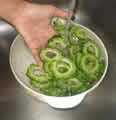
Ampalaya (Bitter Melon) with a scientific name Momordica charantia, is a climbing vine and the tendrils of which grow up to 20 centimeters long. This herbal plant belongs to the family of Cucurbitaceae, and it is a tropical as well as a subtropical vine. Ampalaya leaves are heart-shaped, which are 5 to 10 centimeters in diameter. The fruits of the ampalaya vine are fleshy green with pointed ends at length. It can never be mistaken for any other variety because its ribbed and wrinkled surface had always been ampalaya’s distinct physical structure. The bitter taste of the ampalaya fruit had also been the distinguishing factor from the rest of the fruits with medicinal value, and this is due to the presence of a substance known as momorcidin.
Ampalaya has been a folkloric cure for generations but has now been proven to be an effective herbal medicine for many aliments. Most significant of which is for Diabetes. The Philippine variety has proven to be most potent. Ampalaya contains a mixture of flavanoids and alkaloids make the Pancreas produce more insulin that controls the blood sugar in diabetics. Aside from Ampalaya's medicinal value, it is good source of vitamins A, B and C, iron, folic acid, phosphorous and calcium.
Ampalaya has been for used even by the Chinese for centuries. The effectively of Ampalaya as an herbal medicine has been tried and tested by many research clinics and laboratories worldwide. In the Philippines, the Department of Health has endorsed Ampalaya as an alternative medicine to help alleviate various ailments including diabetes, liver problems and even HIV. Aside from these, ampalaya also helps treat skin diseases and cough. Its herbal value extends to increasing the sterility of women, in parasiticide, antipyretic, and has purgative functions, as well. Note: In large dozes, pure Ampalaya juice can be a purgative and abortifacient.
Medical uses of Ampalaya
Diabetes. Ampalaya fruits and leaves can be eaten as vegetable. Ampalaya tablets and capsules are also now available in the Philippines.Hemorrhoids. Powdered leaves and root decoction of Ampalaya are applied to hemorrhoids as astringent.
 Stomach Problems. Ampalaya leaf juice is used to expel intestinal parasites, treat dysentery, diarrhea, and chronic colitis. Grounded seeds may also be used. Taken in a spoonfull 3x a day until ailment subsides.
Stomach Problems. Ampalaya leaf juice is used to expel intestinal parasites, treat dysentery, diarrhea, and chronic colitis. Grounded seeds may also be used. Taken in a spoonfull 3x a day until ailment subsides.
Cough. Ampalaya leaf juice is used for mild coughs for children. Administered in a teaspoon 3x a day.
Burns, Scalds and Wounds. Pounded Ampalaya seeds or leaf are used to treat burns, scalds and wounds.
Other acclaimed uses are for the treatment of HIV, hypertension, treatment of fever and headaches, treatment of rheumatism and gout, disease of the spleen and liver.
Note: In large dozes, pure Ampalaya juice can be a purgative and abortifacient.
Ampalaya leaves are part of a tropical vine that initially gained wide use for medicinal purposes on the Philippines. Through the years, Ampalaya leaves were used to treat a number of conditions, diseases and ailments. The medicinal use of Ampalaya leaves expanded outside of the Philippines in more recent times.
- Use Ampalaya leaves as a topical treatment to help resolve a number of different conditions. Ampalaya leaves are used to treat more superficial wounds and milder burns. Ampalaya leaves speed the overall healing process and also work to ease the pain associated with wounds and burns.
As a topical treatment, mashed Ampalaya leaves are blended with a white cream or patted onto the wound or burn directly in their ground form.
Ampalaya leaves may also be effective in aiding in the resolution of hemorrhoids. Again, the Ampalaya leaves are ground and applied directly to the hemorrhoids. They act to lessen the swelling and also as an astringent. - Grind Ampalaya leaves to be used in treating certain digestive conditions and ailments. In addressing digestive issues, 1 tsp. of ground Ampalaya leaves are taken three times throughout the course of a day.
In the Philippines, Ampalaya leaves are used to treat diarrhea and colitis. Ampalaya leaves may also be helpful in eliminating intestinal parasites and in the treatment of dysentery. - Incorporate Ampalaya leaves into your diet to aid in regulating diabetes (types I and II). Ampalaya leaves are also available in capsule form for diabetic patients. Ampalaya leaves may assist in regulating blood sugar levels in a person with diabetes.
Before using Ampalaya leaves as part of a regimen to regulate blood sugar, consult with a doctor to ensure that using Ampalaya leaves makes sense for you and that it is an appropriate alternative remedy for your condition. - Add Ampalaya leaves to your diet to better your overall health. In addition to being effective at resolving a variety of common ailments and illnesses, Ampalaya leaves are nutritional. Ampalaya leaves are a useful dietary supplement in addition to having healing properties.
Ampalaya leaves are rich in iron, calcium, beta carotene and vitamin B. These are all important nutrients in maintaining optimal health.
Topical Treatments
Digestive Treatments
Diabetes
Nutrition
No comments:
Post a Comment